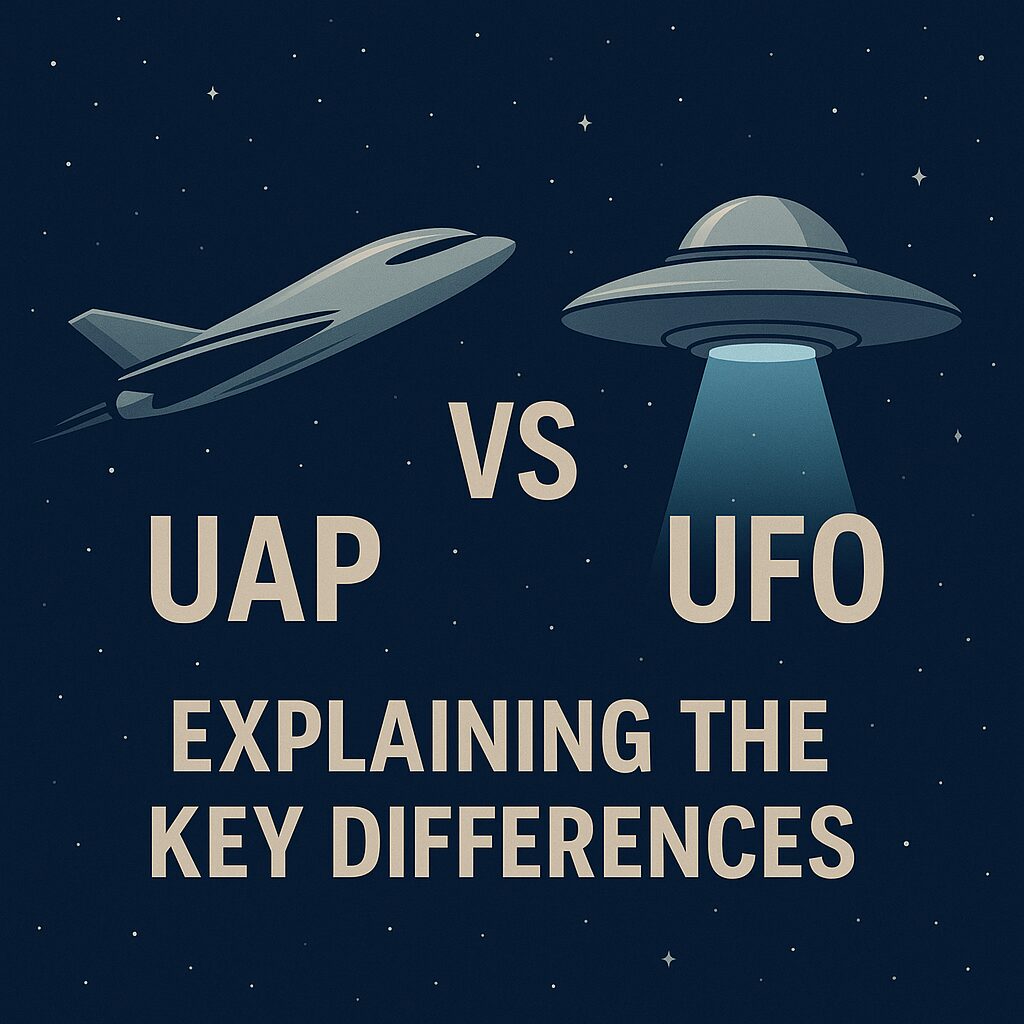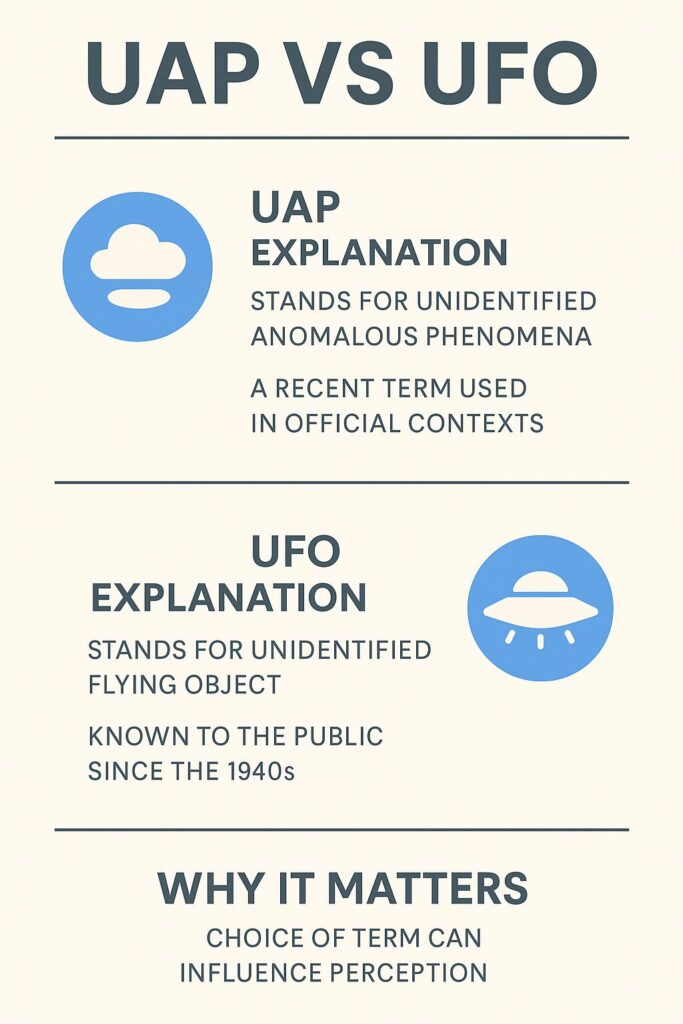
Contents
- Introduction: UAP vs UFO: Explaining Key Differences
- Understanding the UFO Legacy
- The Rise of UAP
- Key Differences Between UAP and UFO
- Why the Shift in Language Matters
- Steps to Evaluate a Sighting
- Broader Implications of UAP Research
- Final Thoughts
- Frequently Asked Questions: UAP vs UFO
- Google–Friendly Quick Answers
- Further Reading and Sources
- Related YouTube Video
- About Paraghosts.com
Introduction: UAP vs UFO: Explaining Key Differences
Discover the UAP vs UFO key differences, exploring how modern terminology, government reports, and scientific perspectives shape today’s understanding of unidentified aerial phenomena.
For decades people have looked to the skies and wondered about mysterious lights and unexplained movements.
Pilots, astronomers, and everyday sky watchers have reported encounters that defy easy explanation. Two main terms appear again and again in these discussions: UFO and UAP.
At first glance they seem interchangeable. Both describe strange objects or lights in the sky that no one can identify right away. But the words carry different histories, meanings, and implications.
Understanding these differences helps us see how society, government, and science approach aerial mysteries today.
This guide explores the complete story of UFOs and UAPs.
You will learn the origins of each term, the unique traits that set them apart, and why modern researchers prefer one over the other.
By the end, you will have a clear understanding of how language shapes our search for answers.
Understanding the UFO Legacy
The Origin of the Term UFO
The phrase Unidentified Flying Object emerged in the late 1940s after the famous 1947 Roswell incident.
Early military reports needed a neutral label for unexplained sightings, so investigators used “flying object” to describe anything airborne that lacked a clear identity.
- Early Military Investigations
- The United States Air Force launched Project Sign in 1948, followed by Project Grudge and Project Blue Book.
- These programs gathered data from pilots, radar operators, and civilians.
- The goal was to rule out threats such as enemy aircraft or experimental weapons.
- Public Fascination
- Newspapers highlighted mysterious lights and “flying saucers.”
- Science fiction movies in the 1950s and 1960s reinforced the connection between UFOs and alien visitors.
- The term quickly became tied to extraterrestrial life in the public mind.
Cultural and Scientific Impact
The UFO label created excitement but also skepticism.
Serious scientists worried that discussing UFOs might harm their reputations.
At the same time, public interest pushed governments to investigate further.
This tension between fascination and doubt still shapes the conversation.
The Rise of UAP
Modern Adoption
In recent years, the term Unidentified Aerial Phenomena has gained favor among governments, researchers, and media outlets.
- Government Use
- The United States Department of Defense uses UAP in official reports.
- NASA also uses the term when describing ongoing studies of unexplained aerial events.
- International agencies have adopted UAP to standardize discussions.
- Why UAP Feels Different
- “Phenomena” includes not only solid objects but also lights, energy patterns, or atmospheric effects.
- The phrase sounds neutral and avoids the science fiction feel of UFO.
- Using UAP encourages scientific inquiry without bias.
Expanding the Scope
UAP covers a wider range of unexplained events:
- Sudden bright flashes that leave no radar signature
- Odd cloud formations or plasma effects in the upper atmosphere
- High-speed objects that evade standard flight pattern analysis
- Drone swarms or advanced aircraft not yet publicly known
This broader definition allows researchers to explore every possibility, from rare weather events to experimental technology.
Key Differences Between UAP and UFO
Detailed Comparison
| Aspect | UFO | UAP |
|---|---|---|
| Meaning | Unidentified Flying Object | Unidentified Aerial Phenomena |
| Focus | Physical flying objects | Any unexplained aerial event |
| Cultural Image | Linked to alien spacecraft and science fiction | Neutral and scientific |
| Common Usage | Media, pop culture, everyday conversation | Government, research, scientific reports |
Core Distinctions
- Scope
- UFOs refer only to physical objects in the sky.
- UAPs include light phenomena, unusual movements, and energy signatures.
- Public Perception
- UFO suggests alien encounters and conspiracy theories.
- UAP presents a professional tone that invites serious research.
- Investigative Approach
- UFO investigations often focused on proving or disproving extraterrestrial life.
- UAP studies explore all natural and technological possibilities.
Why the Shift in Language Matters
1. Encourages Scientific Research
Using UAP removes the stigma that once followed UFO studies. Scientists can propose research without fear of ridicule. Grants and peer reviews are easier to obtain when the language stays neutral.
2. Improves Government Transparency
Recent Pentagon reports on UAP sightings show a willingness to share data. By framing incidents as UAP, officials highlight the need for analysis without fueling alien speculation. This helps the public trust that investigations focus on safety and facts.
3. Shapes Media Coverage
News outlets increasingly use UAP to present balanced stories. This change reduces sensational headlines and keeps the discussion centered on evidence and technology rather than sensationalism.
Steps to Evaluate a Sighting
If you witness something strange in the sky, follow these detailed steps to assess it carefully.
Step 1: Document the Event
- Note the date, time, and location.
- Describe the color, shape, and size of the object or light.
- Record the direction of movement and speed if possible.
- Take clear photos or videos for reference.
Step 2: Check for Ordinary Explanations
- Review weather data for unusual cloud formations or lightning.
- Consider drones, satellites, or aircraft flight paths.
- Look for scheduled rocket launches or military exercises.
Step 3: Compare Multiple Sources
- Ask other witnesses for their accounts.
- Check local news or astronomy groups for similar reports.
- Review radar or satellite tracking if available.
Step 4: Report to Reliable Agencies
- Share findings with organizations like MUFON or the National UFO Reporting Center.
- Provide photos, videos, and all written observations.
- Remain objective and avoid making early conclusions.
Broader Implications of UAP Research
National Security
Unexplained aerial activity can signal advanced surveillance technology. Governments must understand these events to protect airspace and maintain safety for both civilians and the military.
Scientific Discovery
Studying UAP may reveal rare atmospheric phenomena or undiscovered natural processes. Each investigation can expand knowledge of weather patterns, energy forms, and physics.
Cultural Curiosity
The mystery of UAP continues to inspire art, film, and literature. These stories connect people across cultures and spark conversations about life beyond Earth.

Final Thoughts
The change from UFO to UAP is more than a new label. It represents a shift toward careful study, open dialogue, and scientific respect.
Understanding this evolution helps everyone from scientists to casual observers approach the unknown with curiosity and reason.
The skies remain full of wonders. By using clear language and thoughtful methods, we can explore those wonders with open minds and informed questions.
Whether you are an experienced researcher or someone who simply enjoys stargazing, knowing the difference between UAP and UFO will guide you toward deeper understanding and meaningful discovery.
Frequently Asked Questions: UAP vs UFO
What is the main difference between a UAP and a UFO?
The key difference lies in the scope of each term. A UFO refers specifically to an Unidentified Flying Object, meaning a physical object seen in the sky that cannot be immediately identified. A UAP stands for Unidentified Aerial Phenomena and covers a wider range of unexplained aerial events, including lights, energy forms, or unusual movements in the atmosphere.
Why do governments prefer the term UAP instead of UFO?
Governments use UAP because it sounds more neutral and scientific. The word UFO is tied to pop culture and alien theories, which can create bias. UAP encourages serious research and helps agencies present information without sensationalism.
Are UAPs the same as alien spacecraft?
Not necessarily. A UAP simply means something in the sky that is not yet explained. Many UAPs turn out to be drones, balloons, or natural events. While some people believe certain sightings might involve extraterrestrial technology, there is no confirmed proof that UAPs are alien ships.
When did the term UAP replace UFO in official reports?
The shift began in the early 2000s and became common after the U.S. Department of Defense created the UAP Task Force in 2020. Today most official documents and media reports use UAP as the standard phrase.
How can I report a UAP or UFO sighting?
You can report a sighting to recognized organizations such as:
- MUFON (Mutual UFO Network) – Offers online reporting forms and investigation teams.
- National UFO Reporting Center (NUFORC) – Accepts detailed reports and photographs.
- Local astronomy clubs or meteorological agencies – Can help rule out natural explanations.
Provide the date, time, location, photos, and a detailed description for accurate analysis.
What should I do if I see a UAP?
Follow these steps:
- Document the event with time, location, and clear photos or videos.
- Check for natural or technological causes such as weather patterns, drones, or satellite paths.
- Compare with other witness reports and reliable data like radar logs.
- Submit your report to a credible research organization.
Could UAP research lead to new scientific discoveries?
Yes. Investigating UAPs can reveal new insights into atmospheric science, energy phenomena, and advanced aviation technology. Even when sightings have natural explanations, the research expands our understanding of weather, physics, and the limits of human technology.
Do pilots and scientists take UAPs seriously?
Yes. Pilots and scientists often document unexplained sightings carefully. Many UAP cases come from trained professionals who understand aviation and meteorology. Their credible reports are a key reason governments continue to study UAPs.
Google–Friendly Quick Answers
What does UAP mean compared to UFO?
UAP means Unidentified Aerial Phenomena, a modern term covering all unexplained events in the sky, while UFO means Unidentified Flying Object, which refers only to unidentified objects.
Why is UAP now the preferred term?
Agencies and scientists use UAP to remove the pop-culture link to aliens and keep investigations neutral and scientific.
Is a UAP always extraterrestrial?
No. Most UAP sightings are later explained as drones, balloons, or natural atmospheric events.
Further Reading and Sources
1. NASA – Unidentified Anomalous Phenomena (UAP) Study
https://science.nasa.gov/uap
NASA’s official page outlines its independent study of UAP, the scope of its investigation, and key scientific approaches. It offers direct statements, reports, and current updates straight from the U.S. space agency.
2. U.S. Department of Defense – All-Domain Anomaly Resolution Office (AARO)
https://www.aaro.mil/
This is the Pentagon’s dedicated office for UAP analysis. It provides declassified reports, press briefings, and FAQs explaining how the U.S. government defines and investigates UAP events.
Related YouTube Video
UAP vs UFO: What’s the Difference?
About Paraghosts.com
Curiosity about what moves above us continues to inspire investigators and dreamers alike.
At Paraghosts.com, you’ll find in-depth articles, evidence-based research, and captivating stories that explore every corner of the paranormal world.
Whether you are a seasoned investigator or simply fascinated by the unknown, our team brings you trusted resources and fresh insights to keep your sense of wonder alive.

- How to Record EVP on the Jürgenson Frequency - December 28, 2025
- How to Tell if a House is Haunted or Just Old? - December 26, 2025
- How to Tell if an EVP is a Real Voice or Audio Pareidolia - December 19, 2025


